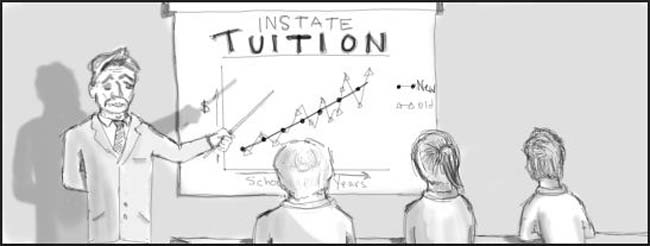On April 19, the College of William and Mary’s Board of Visitors passed the “William & Mary Promise,” a new operating model that includes a tuition pricing system that would set a constant rate for each incoming class of in-state freshmen. The plan guarantees that a Virginia student’s tuition will not increase throughout his four years. It also aims to lower net tuition for middle income Virginians, increasing grants and lowering debt assumption. While the new model will benefit incoming in-state students, it will do little to help out-of-state students, and its promise may place the College’s financial burden on out-of-state students in the event of a severe inflation increase.
Too often, families are left without knowing how much they’ll pay for their children’s education in the coming years, and the only certainty is that they’ll always pay more. However, paying for a college education is an exchange. Prospective students and their parents should already know what services they’re going to be paying such exorbitant fees for, so they should also know exactly how much those services are going to cost — and that’s what this plan accomplishes. The new model will make the college decision process rather straightforward, as it will become abundantly clear and predictable how much in-state students will pay over their four years for the College’s services.
The College’s value comes, in large part, from its people. To attract talented students, we need a talented faculty — and part of that is maintaining competitive faculty salaries. The state goal is to get faculty salaries up to the 60th percentile. Currently, however, faculty salaries are in the 17th percentile and decreasing each year. The College’s new financial model will increase faculty salaries by a maximum of 6 percent — but even more importantly, these salary increases will be merit-based. Faculty will have greater incentives to effectively engage with their students and their material, and more money will go primarily to professors who are best increasing our institution’s value.
College President Taylor Reveley has made clear the political and financial realities preventing the College from increasing financial assistance for out-of-state students, and we acknowledge that. We even appreciate the “William & Mary Promise’s” attempt to lower the gap between in-state and out-of-state tuition rates by increasing in-state tuition rates and only increasing the out-of-state tuition by 3 percent. However, out-of-state students constitute 35 percent of the student body, face more competition for limited spots, take the same classes, live in the same dorms, and yet pay almost twice the tuition rate of in-state students. The College may work hard to promote racial and ethnic diversity, but this policy weakens its socioeconomic diversity by discouraging intelligent, middle class out-of-state applicants. And relying on philanthropy for future aid to out-of-state students — while perhaps one of only a few possible solutions — is a solution that requires long-term focus and is not a reliable option in the short term.
The ambitious nature of the Promise also presents sustainability concerns. What happens if the economy collapses again or the state drastically cuts its funding? Guaranteeing a constant tuition rate will help families but may not allow the College to preserve its quality. As the model does not apply to out-of-state students, they may take the hardest hit if revenue dries up.
Concerns aside, the “William & Mary Promise” is a strong plan that should help in-state students and improve the quality of our education. We hope it succeeds and becomes a model for other schools.
Katherine Chiglinsky recused herself from this editorial to remain unbiased in her reporting.

































